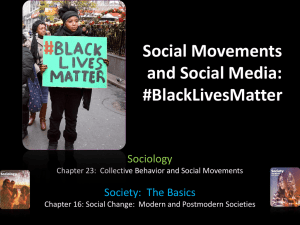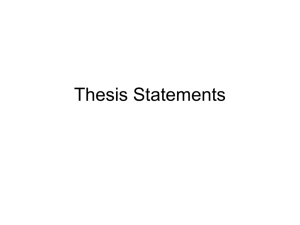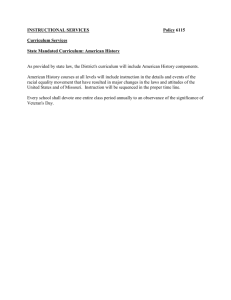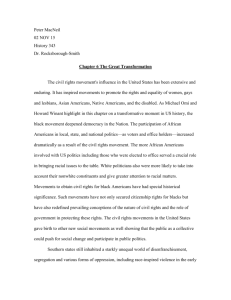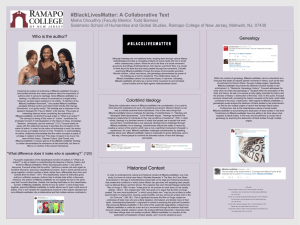Synthetic Write-Up
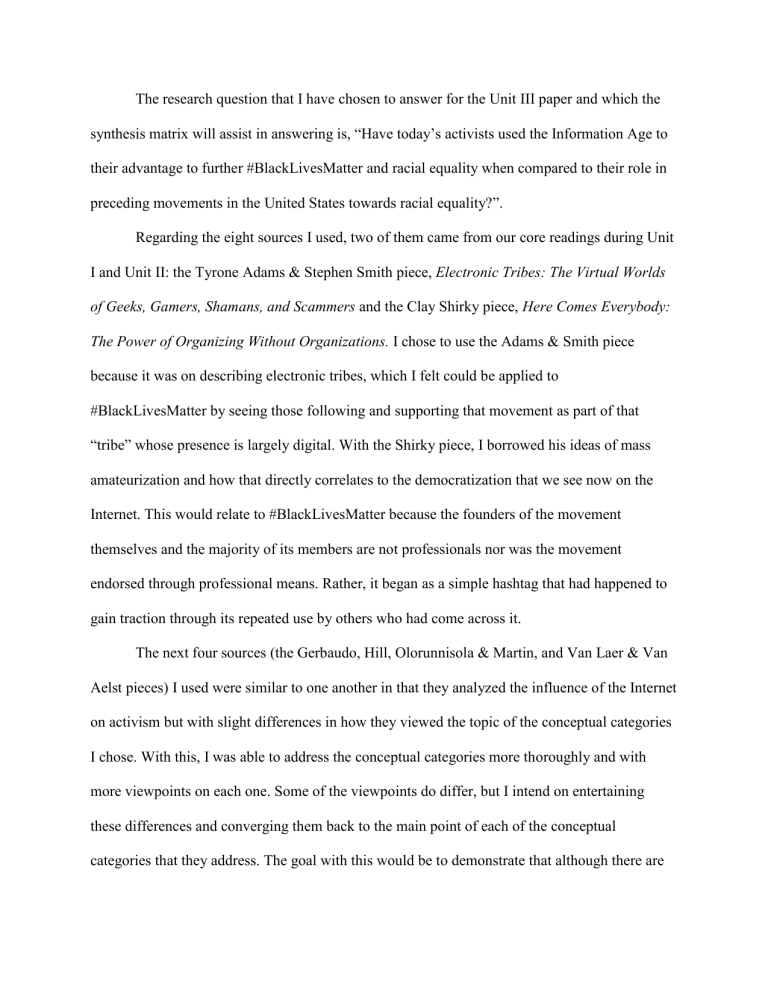
The research question that I have chosen to answer for the Unit III paper and which the synthesis matrix will assist in answering is, “Have today’s activists used the Information Age to their advantage to further #BlackLivesMatter and racial equality when compared to their role in preceding movements in the United States towards racial equality?”.
Regarding the eight sources I used, two of them came from our core readings during Unit
I and Unit II: the Tyrone Adams & Stephen Smith piece, Electronic Tribes: The Virtual Worlds of Geeks, Gamers, Shamans, and Scammers and the Clay Shirky piece, Here Comes Everybody:
The Power of Organizing Without Organizations.
I chose to use the Adams & Smith piece because it was on describing electronic tribes, which I felt could be applied to
#BlackLivesMatter by seeing those following and supporting that movement as part of that
“tribe” whose presence is largely digital. With the Shirky piece, I borrowed his ideas of mass amateurization and how that directly correlates to the democratization that we see now on the
Internet. This would relate to #BlackLivesMatter because the founders of the movement themselves and the majority of its members are not professionals nor was the movement endorsed through professional means. Rather, it began as a simple hashtag that had happened to gain traction through its repeated use by others who had come across it.
The next four sources (the Gerbaudo, Hill, Olorunnisola & Martin, and Van Laer & Van
Aelst pieces) I used were similar to one another in that they analyzed the influence of the Internet on activism but with slight differences in how they viewed the topic of the conceptual categories
I chose. With this, I was able to address the conceptual categories more thoroughly and with more viewpoints on each one. Some of the viewpoints do differ, but I intend on entertaining these differences and converging them back to the main point of each of the conceptual categories that they address. The goal with this would be to demonstrate that although there are
differences in their existing viewpoints, the sources can still agree on the fundamental idea that underlies what they are arguing.
The last two sources I chose didn’t address the Information Age nor any aspects of the
Internet; however, I felt that they played an important part in addressing #BlackLivesMatter apart from its main presence as an Internet hashtag turned social movement. Kenneth Keniston’s
Moral Development, Youthful Activism and Modern Society addresses a deeper psychological level of activism as a whole and Glenn Loury’s Anatomy of Racial Inequality addresses the nature of racism itself, which would be important for the comparison to past racial equality movements.
I had left out certain sources that I had considered using because they ultimately didn’t have much relevance to the research question I decided on in the end. One source I had left out was a piece by Alicia Garza, one of the co-founders of the #BlackLivesMatter movement, called
A Herstory of the #BlackLivesMatter Movement . Because it was written through a feminist lens, it had lost significant relevance once I narrowed my research question more from the one that I started with. A couple of other sources such as Angela Jones’
African American Civil Rights:
Early Activism and the Niagara Movement and Danielle McGuire’s & John Dittmer’s Civil
Rights and the Struggle for Black Equality in the Twentieth Century would have provided relevant examples of the past racial equality movements in America, but they had little relevance other than that. Also, I didn’t consider the comparison to actual past events as the most important part of the research topic to have sources solely used for that purpose so much as the ways in which modern activists have used the time context of the Information Age to their advantage.
The first of the five conceptual categories I chose was “the role of the Internet and social media for #BlackLivesMatter”, which came from the “internet” and “social media” tags. I chose
this category because the majority of my sources addressed it, and the sources that did so all seemed to argue a different degree to which the Internet and social media have affected modern activism and social movements. The second was “#BlackLivesMatter’s activists’ roles and/or the activism that occurs outside of the Internet”, which came from the tag activism, and I chose this because, again, a majority of my sources seemed to address is but seemed to disagree in the presence of any hierarchical nature of the movements. This related to the third category I chose,
“the Internet leading to the democratization of viewpoints and reduction of boundaries for the flow of information and opinions”, which I stretched from the tag internet and social movements, but addressing it in a different way that was more specific to the roles present in the aggregate as a whole. The fourth category was “#BlackLivesMatter as a modern social movement / vehicle by which social change occurs”, which came from the tag social change, and I chose this because almost all of my sources could speak to it adequately to find points where they agree and disagree. The final category I chose was “#BlackLivesMatter and its role relative or in comparison to previous movements towards racial equality and civil rights”, which came from the tags civil rights and racial inequality. I used this to address and answer the comparison part of my research question, thus being why I attempted to stretch all of my sources to address it to some degree.
#BlackLivesMatter activists have used their context in the Information Age to progress their movement further than the preceding Civil Rights Movement in its spread of awareness and influence to action. With the nature of the context, there is less risk in participating in racial equality movements today than in the past, and the Internet is a global and democratized phenomena that allows for the uninhibited spread of information and opinions. Van Laer & Van
Aelst would agree on the global aspect that today’s movements have access to but not without
pointing to certain limitations such as the preexisting social hierarchy also being reflected, determining which movements gain traction. Shirky, however, would most likely beg to differ by arguing for the mass amateurization of the Internet and by saying that professionals (those who would originally be higher in the social structure) are losing the significance of their titles to the everyday citizen who has Internet access. When comparing the role of the Internet to media prior to it (television, radio, etc.), Olorunnisola & Martin would agree that it has allowed for marginalized groups to have a unified voice, which Loury would support as a part of his proposal for “race-egalitarianism”, which is simply the fair and equal treatment of all races. Adams &
Smith would further the argument by mentioning his idea of electronic tribes serving as a community of like-minded individuals with the same concerns, saying that it provides a support source for those marginalized groups to unify under. This concept of unification under a common cause is the role of the #BlackLivesMatter hashtag itself. Seeing that the a large number of social media users are youths, Keniston would argue that the availability and ease of access to these groups by nonmembers can have an influential effect on youths during their moral developmental stages, making the movement possibly grow further from simply influencing those most impressionable. With this growth in popularity, Gerbaudo would say that actions taken in real life seem to take on a larger impact just through sheer numbers of people who had happened to unite mainly because they were aware of #BlackLivesMatter and were able to get information on planned protests. However, Hill would bring perspective to the entirety of the conversation by reminding us that Internet and social media presence is only a tool with which we use for social movements to achieve their goals rather than being the direct cause of social change.
